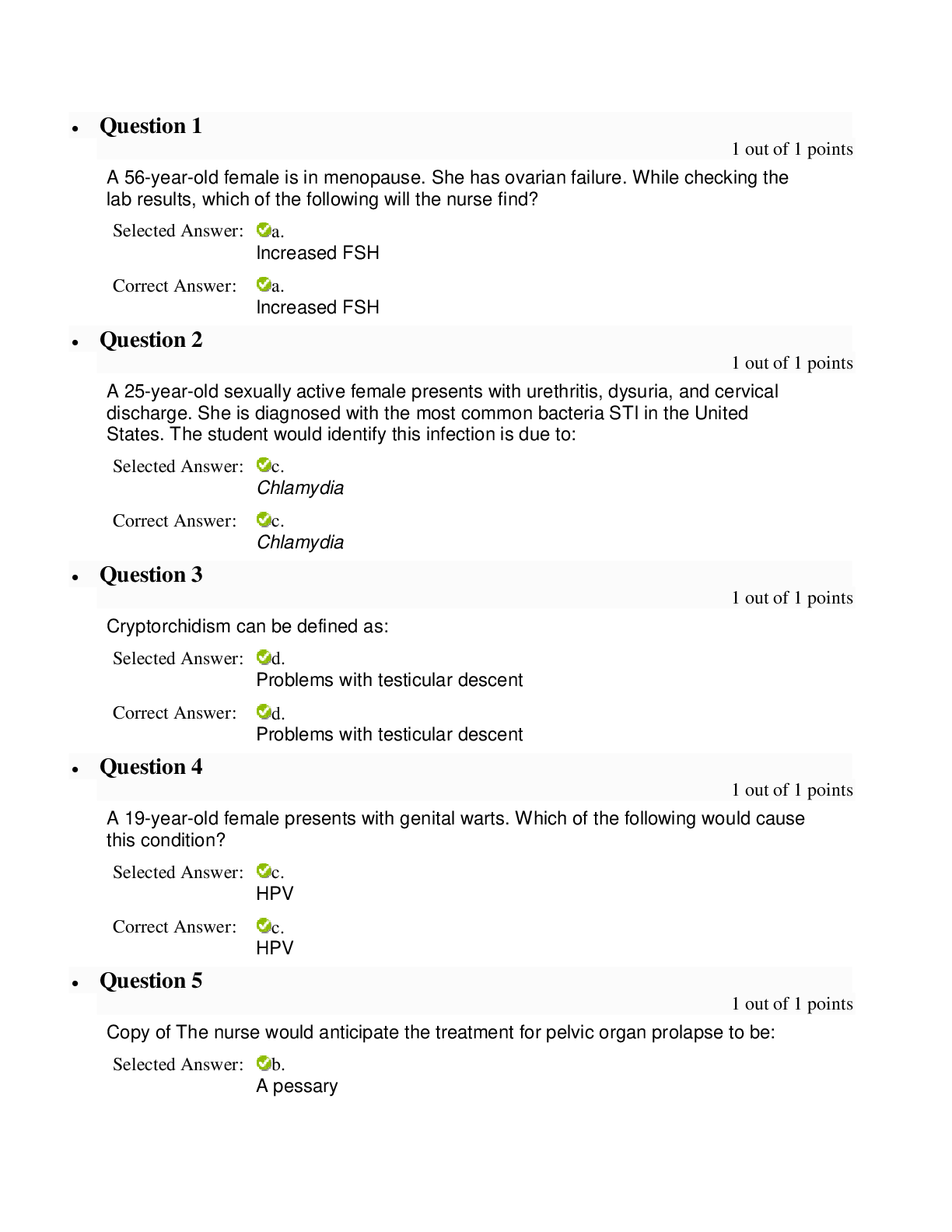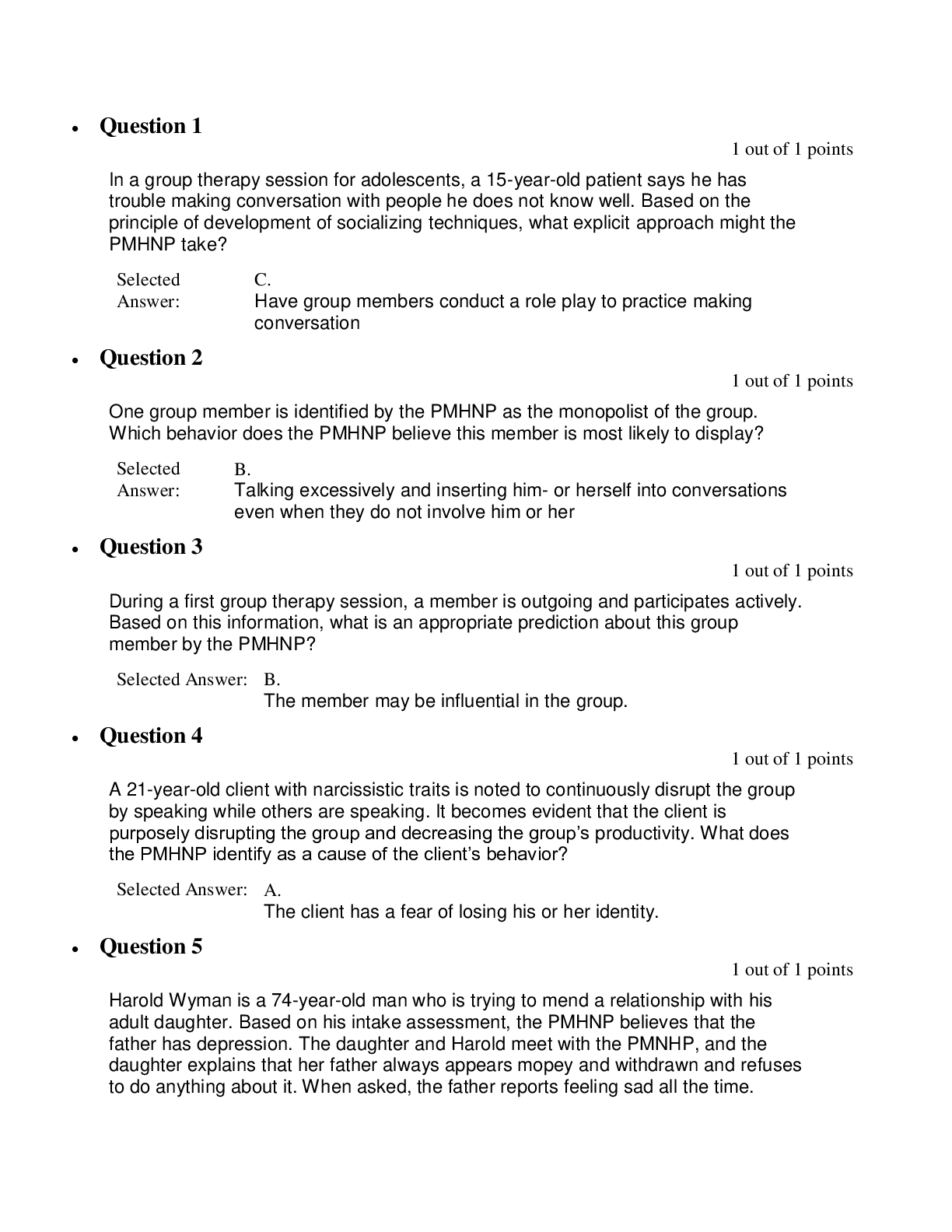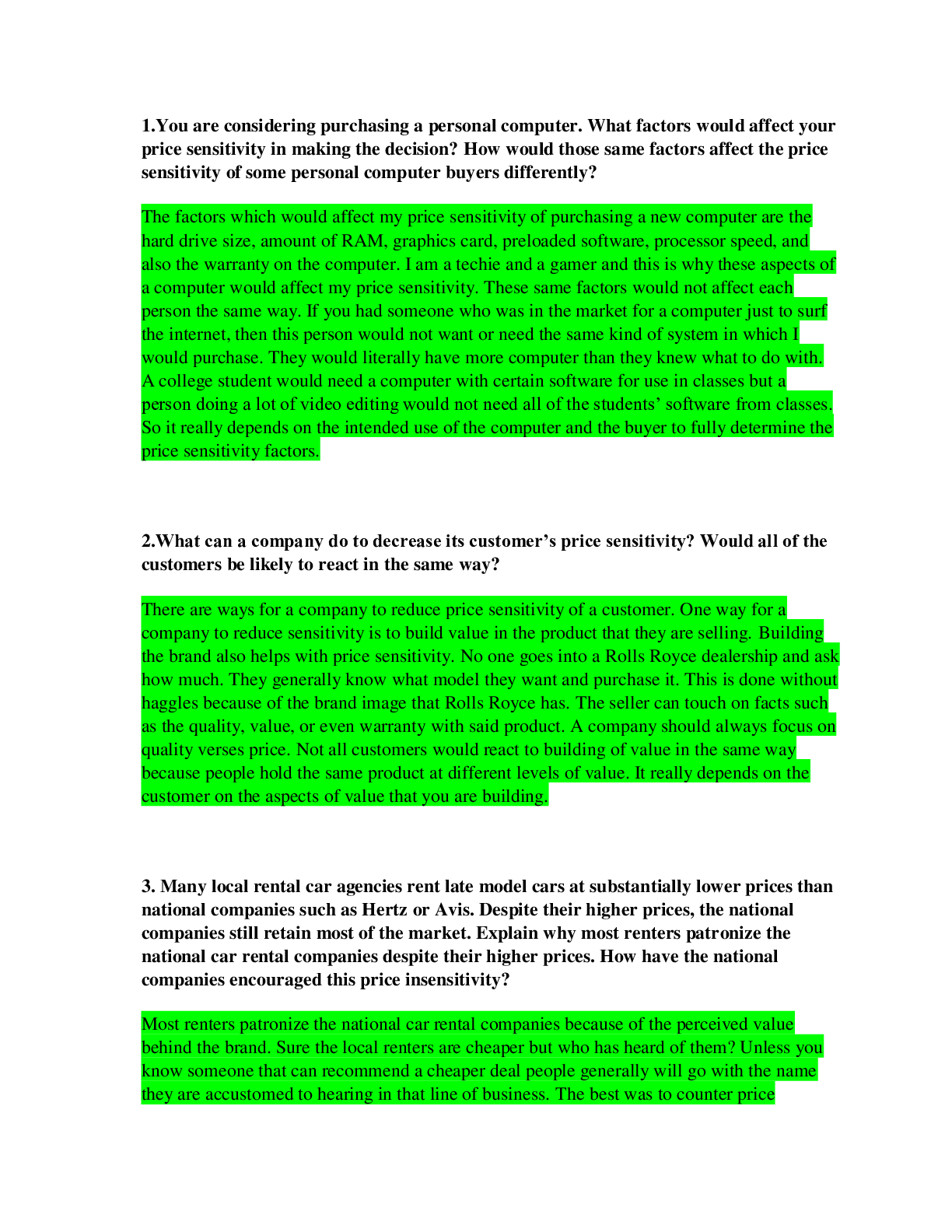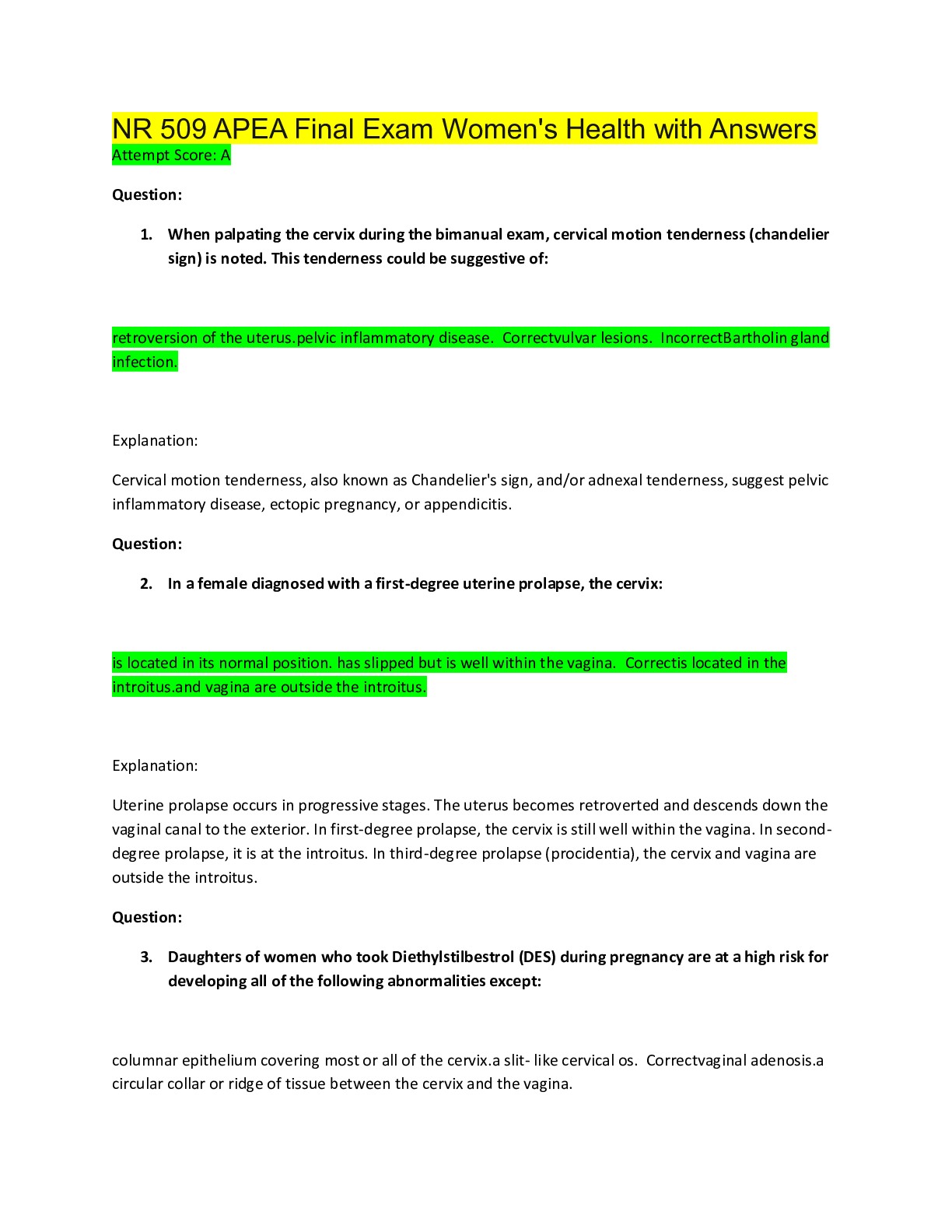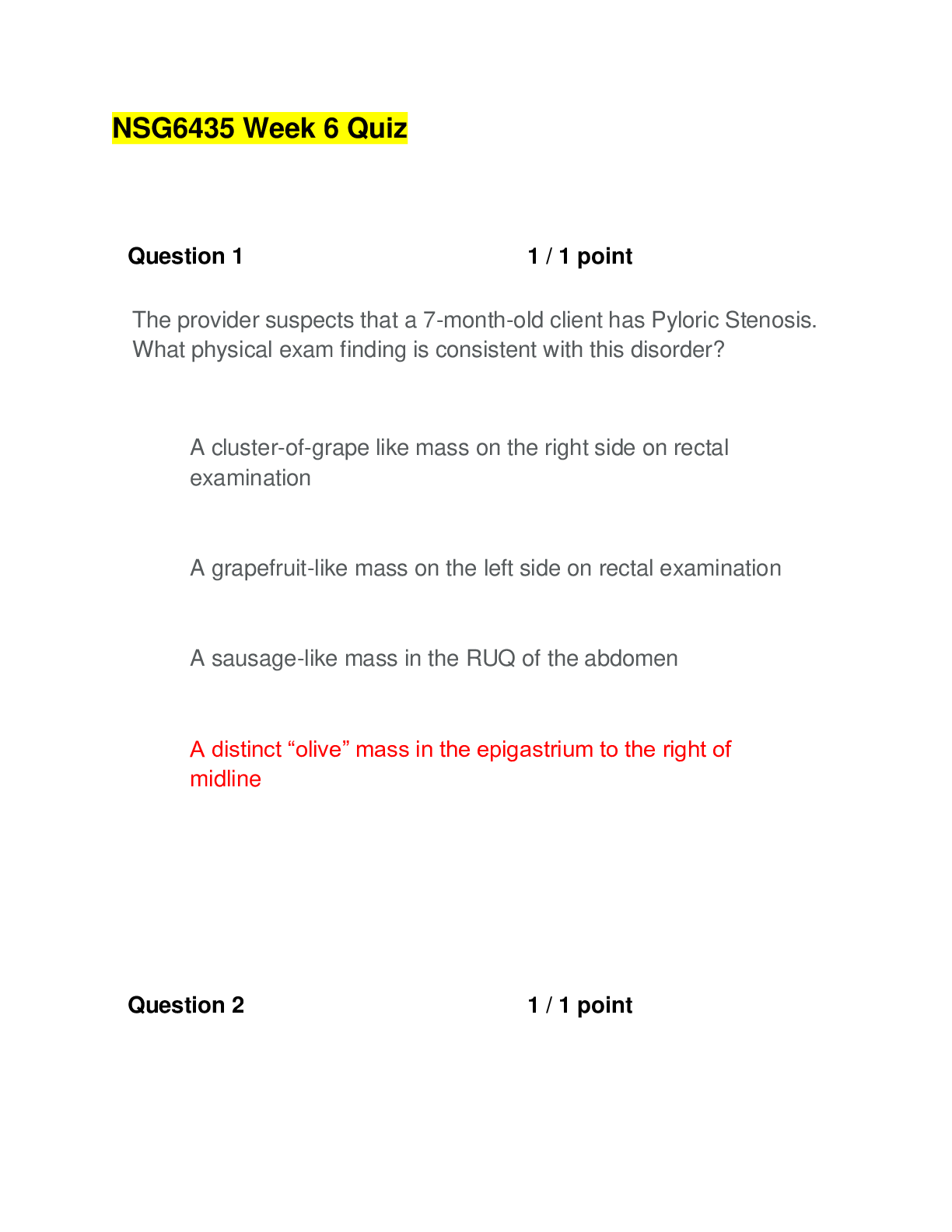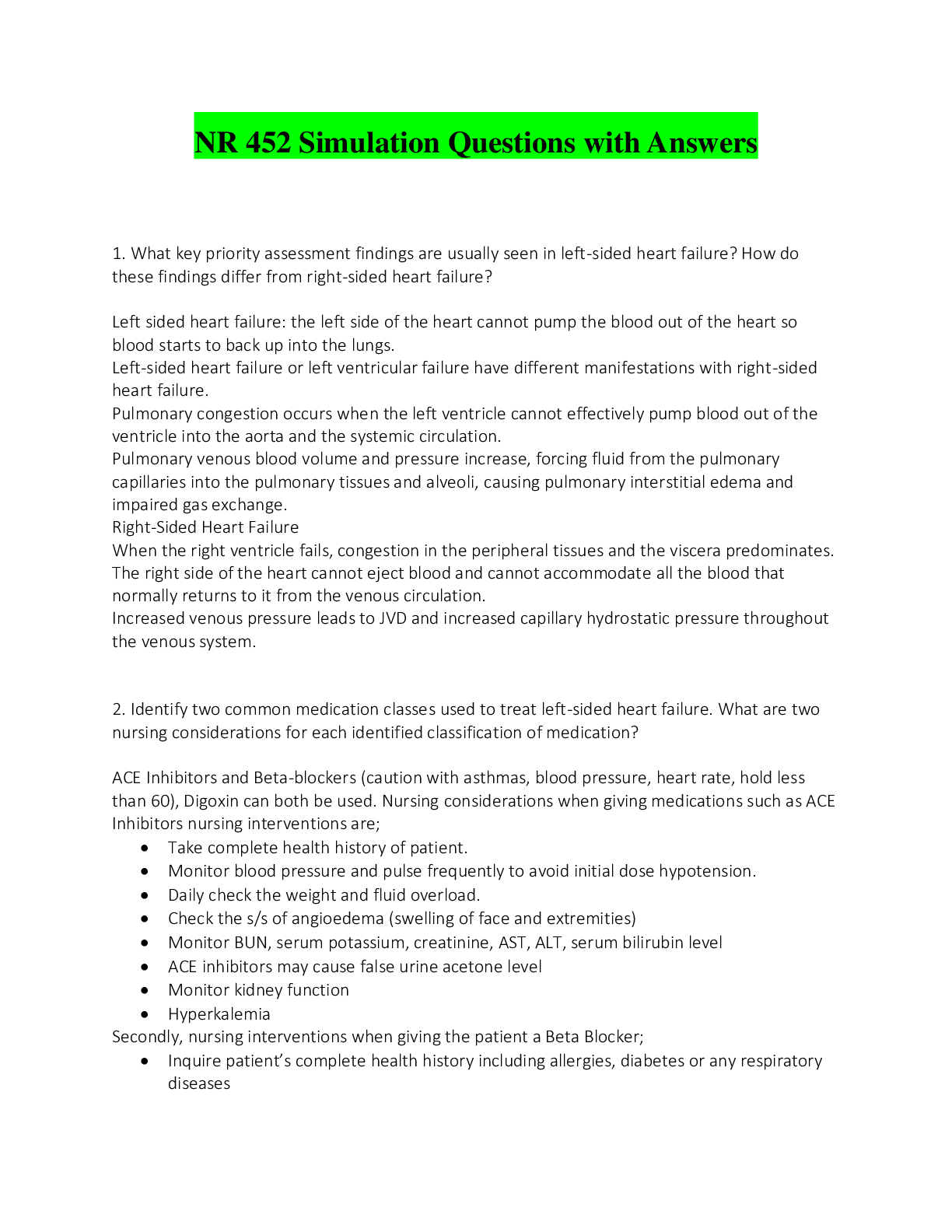*NURSING > EXAM > NURS 6501 Quiz 4 with Answers Walden University (Grade A+plus) | NURS6501 Quiz 4 with Answers (Grad (All)
NURS 6501 Quiz 4 with Answers Walden University (Grade A+plus) | NURS6501 Quiz 4 with Answers (Grade A+plus)
Document Content and Description Below
NURS 6501 Quiz 4 with Answers Walden University (Grade A+plus) • Question 1 1 out of 1 points A 35-year-old male presents with pulmonary hypertension. Testing reveals he is in right heart... failure. Which of the following is the most likely diagnosis the nurse will see listed on the chart? • Question 2 1 out of 1 points Which of the following patients is at highest risk for developing pulmonary embolism (PE)? • Question 3 1 out of 1 points A 60-year-old male is diagnosed with cerebral aneurysm. Where does the nurse suspect the cerebral aneurysm is located? • Question 4 1 out of 1 points A 65-year-old male is diagnosed with chronic pulmonary disease and elevated pulmonary vascular resistance. Which of the following heart failures should the nurse assess for in this patient? • Question 5 1 out of 1 points A 30-year-old Caucasian female was recently diagnosed with primary hypertension. She reports that she eats fairly well, usually having red meat and potatoes daily. She also reports that her father has hypertension as well. A nurse determines which of the following risk factors is most likely associated with this diagnosis? • Question 6 1 out of 1 points A 5-year-old female is found to have hypertension during three separate visits to her primary care provider. The nurse would expect tests to suggest that the hypertension is secondary to: • Question 7 1 out of 1 points A 62-year-old male presents to his primary care provider reporting chest pain at rest and with exertion. He does not have a history of coronary artery disease and reports that the pain often occurs at night. He is most likely experiencing which type of angina? • Question 8 1 out of 1 points A 65-year-old male presents for a routine checkup. A blood pressure check reveals a systolic pressure of 160 mm Hg and a diastolic pressure of 70 mm Hg. Which of the following is the most likely cause of this type of pressure elevation? • Question 9 1 out of 1 points A 60-year-old male undergoes surgery for a bone fracture. Which of the following nursing measures would be most effective for preventing pulmonary embolism (PE) in this patient? • Question 10 1 out of 1 points A 56-year-old male is diagnosed with coronary artery disease. Which of the following modifiable risk factors would the nurse suggest the patient change? • Question 11 1 out of 1 points A 50-year-old female presents with a low heart rate and low blood pressure. She is given an intravenous (IV) infusion of fluids. The increase in atrial distension results in: • Question 12 1 out of 1 points A 52-year-old female is diagnosed with coronary artery disease. The nurse assesses for myocardial: • Question 13 1 out of 1 points A patient wants to know what causes atherosclerosis. How should the nurse respond? In general, atherosclerosis is caused by: • Question 14 1 out of 1 points Which characteristic changes should the nurse keep in mind while caring for a patient with left heart failure? As left heart failure progresses: • Question 15 1 out of 1 points A 65-year-old male is transported to the ER for chest pain. An electrocardiogram reveals a prolonged QRS interval. What is the nurse monitoring when the nurse observes the QRS complex on the electrocardiogram? The QRS complex reflects: • Question 16 1 out of 1 points A 50-year-old male visits the cardiologist for an EKG. Results indicate that he has no PR interval and a variable QRS rate with rhythm irregularity. Which of the following is the most likely diagnosis to be recorded on the chart? • Question 17 1 out of 1 points A 60-year-old male presents to his primary care provider reporting chest pain. He is diagnosed with atherosclerosis. This disease is caused by: • Question 18 1 out of 1 points A 50-year-old obese male with hypertension and coronary artery disease visits a nutritionist for food counseling. He has an elevated level of low-density lipoprotein (LDL) and a low level of high-density lipoprotein (HDL). Which of the following should the nurse advise him to avoid? • Question 19 1 out of 1 points A 50-year-old male with a 30-year history of smoking was diagnosed with bronchogenic cancer. He developed edema and venous distention in the upper extremities and face. Which of the following diagnosis will the nurse observe on the chart? • Question 20 1 out of 1 points Which condition should cause the nurse to assess for high-output failure in a patient? • Question 21 1 out of 1 points What term should the nurse document for a detached blood clot? • Question 22 1 out of 1 points When a nurse checks the patient for orthostatic hypotension, what did the nurse have the patient do? • Question 23 1 out of 1 points A 59-year-old female is diagnosed with left ventricular failure. If a decrease in kidney perfusion occurs, the nurse knows this would ultimately cause: • Question 24 1 out of 1 points A 68-year-old female is experiencing left heart failure. Physical exam reveals elevated blood pressure. The nurse understands this is most likely caused by: • Question 25 1 out of 1 points A nurse monitors the patient for _____ when rapid onset of malignant hypertension results. • Question 26 0 out of 1 points When a patient has a massive pulmonary embolism (PE), what complications will the nurse monitor for? • Question 27 0 out of 1 points A 32-year-old female presents with lower leg pain, with swelling and redness. While obtaining the patient’s history, which finding could have caused her condition? • Question 28 1 out of 1 points An 80-year-old female is in the hospital for a bone fracture. While there she develops a large, nonlethal pulmonary embolus. Which of the following is a direct result of the obstruction to pulmonary blood flow? • Question 29 1 out of 1 points Many valvular stenosis and regurgitation disorders in adults have a common etiology. Which of the following conditions should alert the nurse that the patient may have both types of valve dysfunction? • Question 30 1 out of 1 points A 75-year-old female has been critically ill with multiple organ dysfunction syndrome (MODS) for longer than a week and has developed a severe oxygen supply and demand imbalance. The statement that best describes this imbalance is which of the following? [Show More]
Last updated: 2 years ago
Preview 1 out of 11 pages

Buy this document to get the full access instantly
Instant Download Access after purchase
Buy NowInstant download
We Accept:

Reviews( 0 )
$10.50
Can't find what you want? Try our AI powered Search
Document information
Connected school, study & course
About the document
Uploaded On
Jul 20, 2020
Number of pages
11
Written in
Additional information
This document has been written for:
Uploaded
Jul 20, 2020
Downloads
0
Views
73








 – University of the People.png)





